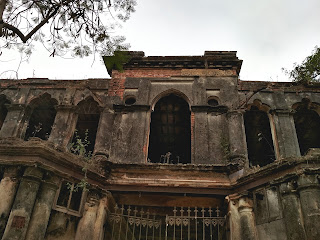A Brahman named Nrisimha Sanyal Chakravarti, originally belonging to Vikrampur in Dhaka, migrated to Balihar about 250 years back and settled at this place. He took up employment under the Khan, zamindar of Balihar, rose to high position, married his patron's daughter and secured a 'taluk'. His grandson, Ramakanta Sanyal received the title of 'Ray' as a personal distinction. His estate, after his death, was extended by his descendants with grants from Rani Satyabati of Bahirband. Ramakanta's eldest son, Krishnenda married the sister of Rani Satyabati and received Lakshmanpur in Saruppur Pargana as dowry from whom the Lakshmanpur zamindarfamily originated. Ramram and Prankrishna. the second and third sons of Ramakanta held important posts in the Rani's zamindari and received in 1733 the grant of Bahirband Pargana from her, besides several 'taluks'. This, in fact, laid the real foundation of the Balihar estate in Rangpur and Dinajpur. The property, originally jointly owned, was eventually divided between Ramram and the eldest son of Prankrishna. From them the nine-anna and seven-anna zamindaris were created. The Balihar Palace was built by the descendants of Ramchandra, a shareholder of seven-anna zamindari. The estate was futher extended by. Ramchandra's grandson, Rajendra Ray by marrying Kasiswari Devi, the daughter of Raja Ramkrishna of Natore. The dowry and subsequent gifts of the Natore Raj made Rajendra the owner of extensive properties in Rajshahi, Bogra and Pabna. Rajendra died in 1823 but one of his descendants, named Krishnendra Ray was conferred with the title of 'Raja'. He adopted Saradindu Ray. a scion of the nine.anna estate, who later recyved the courtesy title of 'Kumar' from the government. His only son and heir was Bimalendu, who was born in 1898.
-Nazimuddin Ahmend, Buildings of The British Raj
-Nazimuddin Ahmend, Buildings of The British Raj





















No comments:
Post a Comment